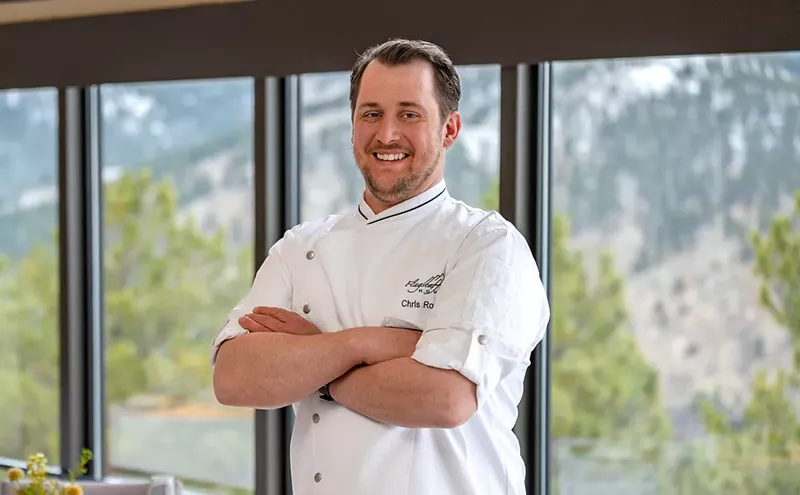Colin Mallet, executive chef at Sassafras American Eatery, thinks Sunny Gardens is Denver's most underrated restaurant. It's so underrated that I'd never even heard of it.
I Googled the name, found a Sunny Gardens — then checked to see if I'd read Mallet's Chef and Tell answer wrong, because this wasn't the chef-driven, farm-to-table, nose-to-tail concept I would have expected from one of the city's notable chefs. Judging from the website, Sunny Gardens was a neighborhood Chinese joint, the sort of spot you run into when it's raining and you can't wait to curl up on the couch with moo shu pork and season four of Breaking Bad. Turns out I'd driven by the place, which is just east of I-25 on Yale Avenue, at least twice a day for years, and had even stopped off for groceries in the same strip center — but I'd never noticed the restaurant.
See also: A Closer Look at Sunny Gardens
So one rainy night when I didn't feel like cooking, I dropped in.
One of the delivery boys hustled over to hold the door. "Sit anywhere you like," he said, gesturing to a clean, orderly room decorated with parasols, green plants and perfectly straight rows of spotless tables, most of which were empty save for two moms with a bunch of kids and one solo elderly diner, all of whom were clustered near the flat-screen TV in the corner. We chose a spot near the TV, too, because even in public, there's something about the loneliness of rainy days that makes you crave the comforting background noise of television.
Happy to be a) warm, b) dry and c) not cooking, we ordered whatever sounded good, not stopping to tally dishes to see if we were ordering too much: moo shu pork, because shredded cabbage and plum sauce go better with a rainy day than galoshes; steamed pork buns, with sweet white skins made shiny by a stint in the steamer; wide-noodled chow fun; kung pao beef with peanuts; and a spin-off of gai pad krapow, the spicy Thai dish with basil and jalapeños (the menu includes a Thai section), plus cups of hot-and-sour and wonton soup that were included with the entrees. At the last minute I threw in an order of pork fried rice, because if memory served correctly, that's what Mallet had singled out. Later, when I pulled up his Chef and Tell Q&A, I saw that Mallet had indeed named the pork fried rice as what he wants when he's "too tired to cook," adding, "I can't live without it."
After trying it, I understood what he meant — and not just because fried rice is one of my guilty pleasures. Sunny Garden's version had the intense porkiness you're more likely to find these days in porchetta, the Italian dish of stuffed, rolled roast pork. A study in tan, with nary a green pea or carrot in sight, the fried rice's only color came from pork, the bright-red kind you sometimes see hanging in the window of a Chinese restaurant. Chef-owner Sunny Chen, who worked as a cook in his native China before moving to New York and later Colorado, roasts his own, using food coloring to impart that vibrant color. At this restaurant, though, Daytona 500 Bud banners, not pork, hang in the windows.
Pork plays a prominent role in other dishes. We liked the moo shu, which stuffed ample amounts of pig into pancakes sturdy enough to hold all that dripping filling without breaking apart. Less interesting were the pork buns, which are not made in-house. The chow fun, with just enough sauce to coat the noodles, also scored, one of several noodle-based dishes to do so. But the basil jalapeño chicken, its licorice notes diluted by extraneous vegetables and too much sauce, was disappointing, and the kung pao beef could've been mistaken for any number of brown-sauce dishes except for the few peanuts sprinkled on top. In all, it wasn't the best or worst Chinese food I've eaten — but aside from that pork fried rice, it was about what I'd expect from a friendly neighborhood joint.
Until I discovered Sunny Gardens' large selection of entrees featuring mock meat. The better part of a page is devoted to its "all natural vegetarian menu," which touts no cholesterol, no eggs, no MSG (it's not used in the kitchen at all), olive rather than vegetable oil, and, of course, no meat. The dishes here include beef with cashews, sesame chicken and chicken and eggplant in garlic sauce — all made with fake chicken and fake beef. I'm not sure what's in the stuff besides the soybeans, seaweed, mushrooms and vegetables listed on the menu, but there's clearly something more, since those ingredients alone wouldn't quite add up to the flavored, colored forms you'll find on your fork.
A few years ago in Taiwan (that's where Sunny Gardens gets its mock meat), inspectors found traces of real meat in supposedly vegetarian meat products. Regulations have reportedly fixed this, but it's still difficult to determine what you're getting, especially since the three servers who came over to answer our questions seemed just as perplexed as we were. "I don't know for sure if it's organic, but I think there's a certificate up front," said one. "I don't really know what's in it," said another. "I don't eat it." Apparently lots of people do, though. Through a translator, Chen estimated that 20 percent of his business comes from the vegetarian menu. (Sixty percent is takeout or delivery, which explains why the restaurant never looks full.)
At home, as I sifted through a fridge full of takeout containers (I over-ordered on all of my visits to Sunny Gardens), I tried to remember which dishes contained fake and which real meat. The shrimp in the curried Singapore chow mei fun, another knockout noodle dish, was real. The shrimp in the vegetarian triple delight was not; the mock shrimp's squeaky texture was closer to a fish ball than the real thing. Beef was harder to judge, and I had to take a few bites of cold lo mein to remember that the brown slices mixed with long strips of celery, carrots and onions were fake, whereas the beef in the spicy green curry, with more paste than coconut milk, had once roamed the earth. Gingery pan-fried pork dumplings had to be real: The menu doesn't offer mock pork.
Around the world, soy-based meat substitutes are big business, consumed not just by people who don't eat animals for reasons of health or animal welfare, but by those whose religion forbids it. The market has so much potential that scientists spend a good deal of time trying to improve the options. A few years ago, I read about a team at the University of Missouri that had worked for a decade to develop ersatz chicken with a realistic mouthfeel and the uneven texture of muscle tissue. The mock chicken in my Hunan chicken didn't come close to that, with smooth droplets of seasoned (and seemingly highly salted) meat substitute that had a bouillon-cube aftertaste, leading me to wonder if fake meat also comes in prime, choice and select.
I still don't know all the ingredients in mock meat, or how it compares health-wise to the real thing in terms of cholesterol or sodium. Taste-wise, it's often good enough — especially when coated in soy-based sauces flecked with chile flakes — to make you not care, particularly if you're home watching reruns on a rainy day. Still, I'd prefer to follow Mallet's advice and pick up a carton of pork fried rice instead.











